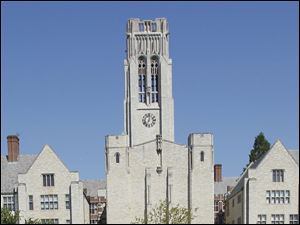
EDITORIAL
Rethinking student loans
3/20/2015
Loan debt often is towering for students at institutions such as the University of Toledo.
Americans owe a mind-boggling $1.2 trillion in student loan debt — almost double what we owe on credit cards and auto loans. Nearly 17 percent of Ohioans who borrowed to finance their education have defaulted, a higher rate than in almost any other state.
Borrowers who find themselves deep in student loan debt are too often out of luck. In almost all cases, student loans aren’t dischargeable in bankruptcy, the process that provides consumers relief from crushing debt they can’t pay off.
A bill before the U.S. Senate would enable private student loans to be forgiven in bankruptcy. But that wouldn’t help the vast majority of borrowers, because the federal government makes 90 percent of student loans. Americans need a better strategy to deal with this debt crisis.
Graduates of the University of Toledo in 2013 shouldered more than $29,000 of debt, on average. At Bowling Green State University, the Class of 2013 owes an average of nearly $31,000.
Debt loads are compounded by unreasonably high interest rates — 4.66 percent this year for undergraduates, even higher for graduate students. These rates are designed to generate profit for the federal government.
President Obama proposes helping graduates manage their debt through an ambitiously billed “student aid bill of rights.” But the plan would amount only to requiring private lenders to be more transparent to borrowers and creating a website where borrowers can keep track of multiple loans and file complaints.
Democratic senators have introduced a bill that would reverse a 2005 law preventing debtors from gaining relief from private student loans in bankruptcy cases. Another, more promising bill introduced this week would allow borrowers to refinance their loans at lower interest rates, so that students aren’t locked into high rates for life. Senate Republicans blocked an identical measure last year.
All these proposals would help, but they would make only modest tweaks to a badly broken student borrowing system. Borrowers who fail to repay their loans on time can have their paychecks and Social Security benefits garnished, and have almost no exit options. Congress must help students who are in dire straits get relief from federal loan debt, through bankruptcy or another process.
Policy experts have floated ideas such as automatically enrolling borrowers in an income-based repayment plan, an option that caps payments at a small percentage of borrowers’ earnings and forgives outstanding debt after 20 years. Many graduates who borrowed after 2007 are eligible for such a program, but few know it exists.
Any plan to relieve student debt must also address the sources of runaway college costs. Tuition has risen at a higher rate than those of food, housing, and even health care in recent years, thanks to a range of pernicious factors: sharp decreases in public aid, the rise of faculty unions and increases in professors’ pay, and exorbitant spending on athletics.
Gov. John Kasich has appointed a task force to recommend cuts in spending by Ohio public universities, passing the savings on to students. His efforts are promising and could offer a model to other states seeking to reduce college costs.
Lawmakers on the left and right recognize that the student loan crisis threatens cherished American values. If they’re serious about preserving the American dream for this generation, they must make serious reforms to the federal financial aid program, starting with lower interest rates and bankruptcy relief.